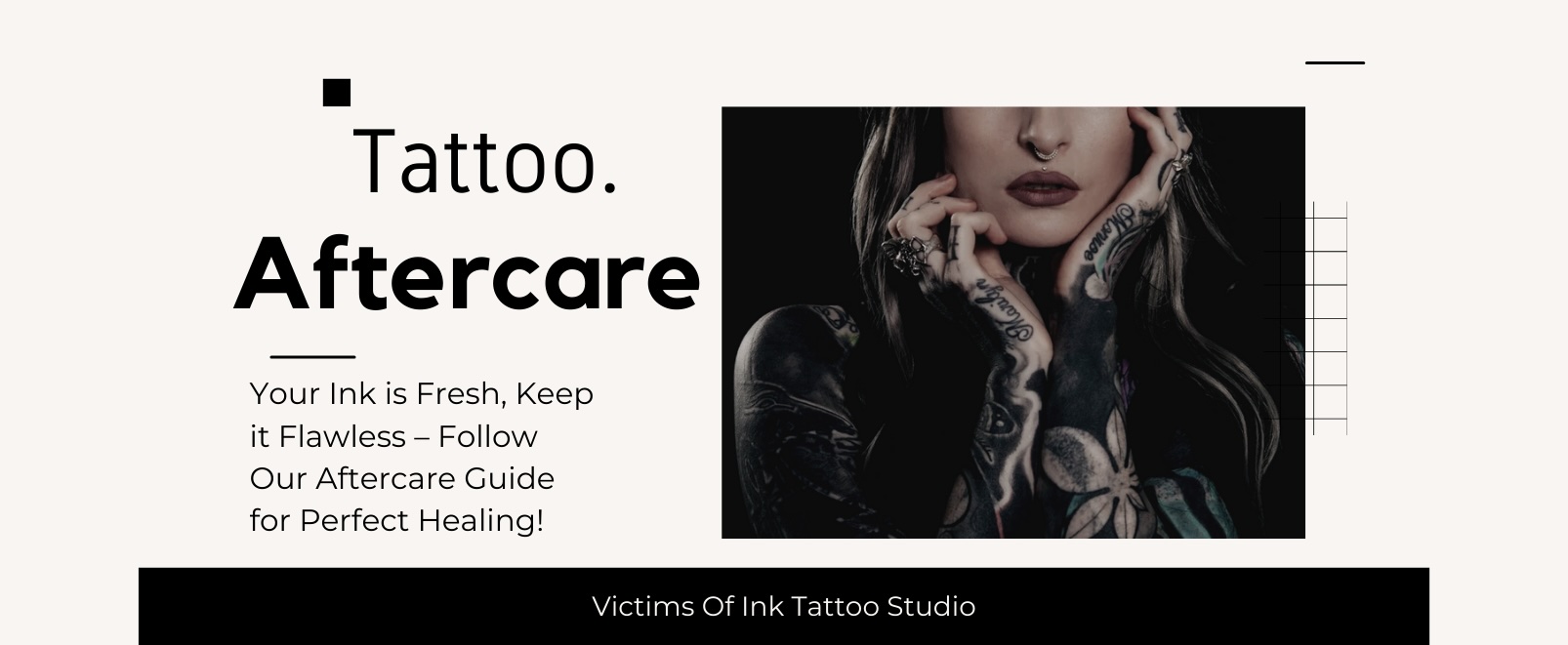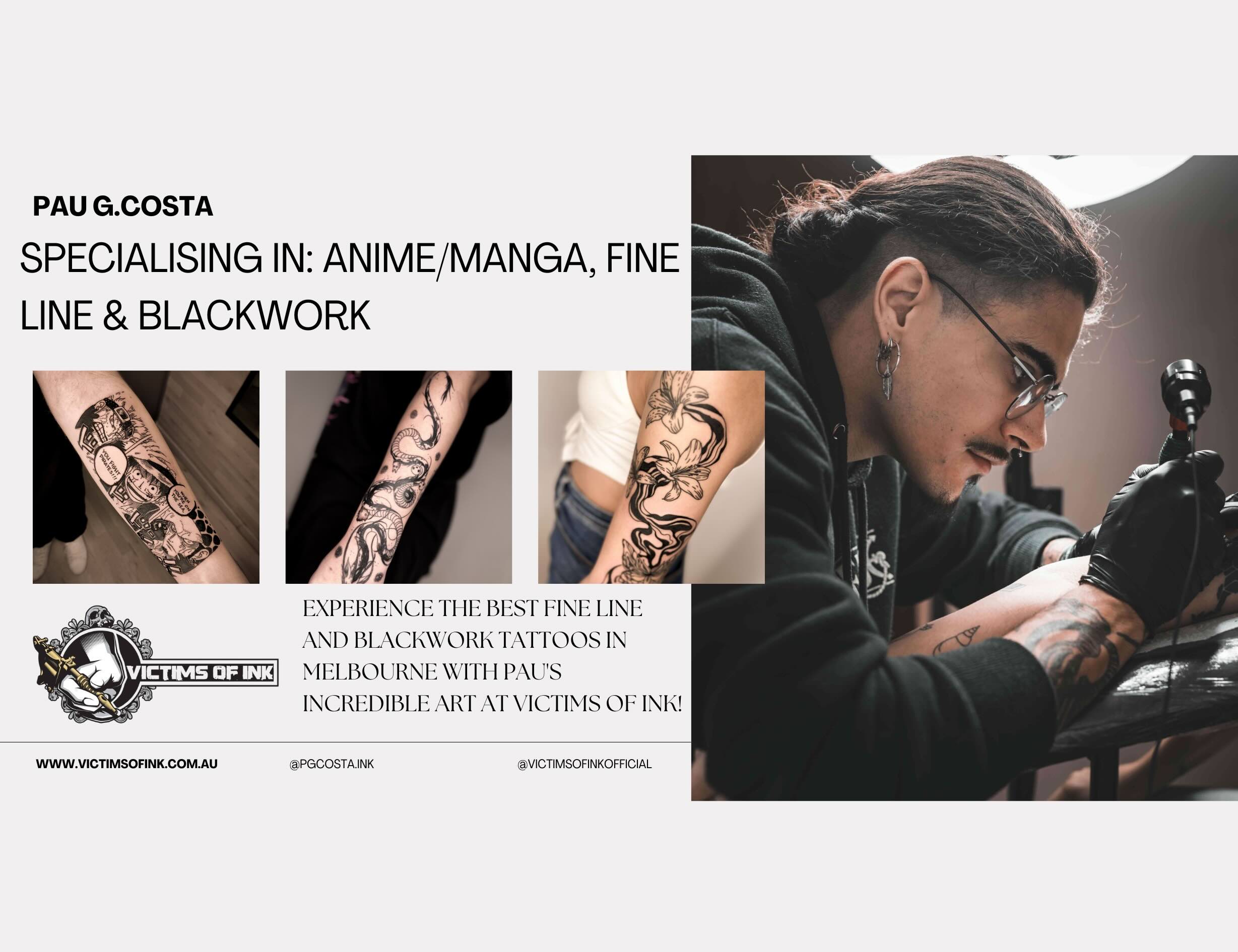Getting a tattoo is an exciting experience, but your journey doesn’t end once you leave the studio! Proper tattoo aftercare is essential to ensure your new ink heals well and looks its best for years to come. At Victims of Ink Tattoo Studio, we want your tattoo to be a masterpiece from day one, so we’ve put together this aftercare guide to help you care for your fresh tattoo.
Why Tattoo Aftercare is Important
Your tattoo is essentially an open wound, and like any wound, it needs the right care to heal properly. Without the right aftercare, you risk infections, fading, and other complications that can affect the appearance of your tattoo. By following the right steps, you’ll protect your skin, ensure vibrant colors, and help your tattoo heal without issues.
The First 24 Hours: Immediate Care
After your tattoo session is complete, your artist will clean the area and apply cling film. This covering protects your tattoo from bacteria and keeps it safe from rubbing against clothing.
- Keep the Bandage On: Leave the covering on for at least 2-4 hours, or as advised by your tattoo artist.
- Avoid Touching: Resist the urge to touch or pick at your tattoo, as this can introduce bacteria.
- Clean the Area: Once you remove the cling film, gently wash the tattoo with lukewarm water and a mild, fragrance-free soap. Pat it dry with a clean towel (don’t rub!).
Days 1-3: Healing Begins
The first few days are crucial for setting up a good healing foundation. Your tattoo will likely ooze plasma, which is normal, but keeping it clean is key.
- Wash Gently: Clean your tattoo twice a day (morning and night). Use lukewarm water and mild soap to remove any plasma buildup. Avoid soaking the tattoo in water—showers are fine, but skip the bath or swim for now.
- Apply a Thin Layer of Ointment: After cleaning, apply a thin layer of unscented, tattoo-safe ointment (like Bepanthen or a product recommended by your artist). Don’t overdo it—too much moisture can suffocate your tattoo.
Days 4-14: Peeling and Scabbing
At this stage, your tattoo will start to scab and peel, much like a sunburn. This is completely normal, but it’s important to care for it properly to avoid complications.
- Moisturize: Switch to a fragrance-free moisturizer to keep the skin hydrated but avoid applying too much product.
- Don’t Pick or Scratch: The peeling and scabbing can be tempting to touch, but picking at it can lead to scarring and loss of ink. Let it peel naturally.
- Wear Loose Clothing: Tight clothes can rub against your healing tattoo and irritate the skin. Opt for loose, breathable fabrics.
Weeks 3-6: The Final Stretch
By now, your tattoo will be well on its way to healing, but it’s still important to be cautious, as deeper layers of the skin are still recovering.
- Continue Moisturising: Keep the skin hydrated to prevent cracking or dryness. Moisturising twice a day is typically sufficient.
- Stay Out of Direct Sunlight: Sun exposure can fade your tattoo, especially during the healing phase. If you have to be in the sun, cover your tattoo or use a high-SPF sunscreen once it’s fully healed.
Long-Term Care: Keep Your Tattoo Looking Fresh
Even after your tattoo is fully healed, proper care will keep it looking vibrant for years to come.
- Use Sunscreen: The sun is the biggest enemy of your tattoo’s longevity. Always apply a high-SPF sunscreen when your tattoo will be exposed to sunlight.
- Keep Your Skin Moisturised: Hydrated skin helps preserve your tattoo’s colour and clarity.
- Touch-Ups: Over time, your tattoo may need a touch-up, especially if it’s in an area that experiences a lot of movement or friction. At Victims of Ink, we’re happy to offer touch-ups to keep your ink looking sharp.
Common Tattoo Aftercare Questions
How long does a tattoo take to heal?
On average, a tattoo takes about 2-3 weeks to surface heal, but the deeper layers of skin can take up to 6 months to fully recover. Healing times can vary based on size, placement, and your personal skin type.
Can I work out after getting a tattoo?
It’s best to avoid strenuous activity that might cause excessive sweating or friction on the tattoo for at least the first few days. If you must work out, try to avoid exercises that put pressure on the tattooed area.
When can I go swimming again?
Avoid swimming in pools, oceans, or hot tubs for at least 2-4 weeks. Water can carry bacteria, and prolonged exposure can soften the scabs and lead to fading.
Is it normal for my tattoo to itch?
Yes, itching is a common part of the healing process. However, don’t scratch! Instead, apply a moisturiser to soothe the skin.
Tattoo Aftercare for Second Skin
If your tattoo artist applies a second skin bandage to your fresh tattoo instead of cling wrap, you can leave that on for 4-5 days. The second skin bandage creates a protective barrier that helps prevent infection and promotes faster healing.
When to Remove Second Skin:
- 4-5 days after the tattoo
- If the second skin begins to peel off before 4-5 days have passed, you should remove it as soon as possible to avoid trapping bacteria in the bandage, which could lead to an infection.
- If you notice a lot of liquid in the bandage, remove the second skin early. This is normal plasma oozing from the tattoo, but leaving it trapped can increase infection risk. If you are unsure whether you should remove the bandage early, contact your artist or Victims of Ink for advice.
How to Remove Second Skin:
When it’s time to remove the second skin, start by washing your hands thoroughly with soap and water. Then, lift a corner of the film and slowly pull it off while holding the skin taut. If you encounter difficulty during the removal, you can do this in the shower or under lukewarm water to aid in the process. Be gentle to avoid pulling on the skin and causing discomfort.
After removing the second skin, gently wash the tattooed area with mild, fragrance-free soap and water. Pat the area dry with a clean paper towel and allow it to air dry for a few minutes. Once dry, you can proceed with the normal aftercare.




